The King Tiger II Ausf. B
This German King Tiger II Ausf. B Heavy Tank can be found at the French Tank Museum in Saumur in the Loire Valley. The Museum is called Musée des Blindés ou Association des Amis du Musée des Blindés, 1043, route de Fontevraud, 49400 Saumur, France www.museedesblindes.fr . The word Blindés means armoured. A train from Paris Montparnasse Railway station to Saumur only takes two hours.
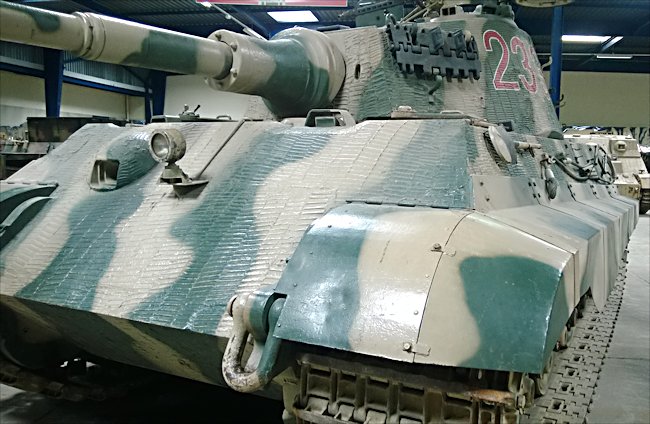
German King Tiger II Ausf. B Heavy Tank
Specifications
The Panzerkampfwagen VI Ausf. B Tiger, also commonly referred to as the Köningstiger, King Tiger, Royal Tiger or Tiger II tank was armed with a 88 mm (3.46 in) KwK43 L/71, 86 rounds and two or three 7.92 mm (3 in) MG 34 machine guns, 5800 round. Its armour ranged from 25mm to 180mm. It had a crew of five: commander, driver, gunner, loader and radio operator/machine gunner. It was powered by a V12 Maybach HL230 P30 690hp petrol engine. It weighed 69.8 tonnes. It had a top road speed of 35km/h (24mph). It had an operational range of 170 km (110 miles). Total production was 492 tanks.
This tank's history
According to an article from the Musée des Blindés French Tank museum's magazine n° 54, this King Tiger tank, which now carries the turret number 233, is believed to be tank number 123, which belonged to the 1st Company, 101 SS Panzer Abt in August 1944. It is believed to have been abandoned by its crew on 23 August 1944, due to engine problems, at Brueil-en-Vexin, near Mantes-la-Jolie. It was salvaged by the French Army in September 1944, and then stored at the AMX Tank factory at Satory before being transferred to the museum in 1975.
French Army Colonel Aubry decide to put 233 on the turret to remember the King Tiger which destroy his own Sherman at end of war. Colonel Aubry is the man who set up the French Tank Museum in the year 1970. He was the first Director of museum. Unlike some of the captured German Panther tanks, this Tiger II tank was never used by the French Army after WW2.It was not modified in any way and kept in the dry at AMX Satory. For a long time it was just forgotten about.
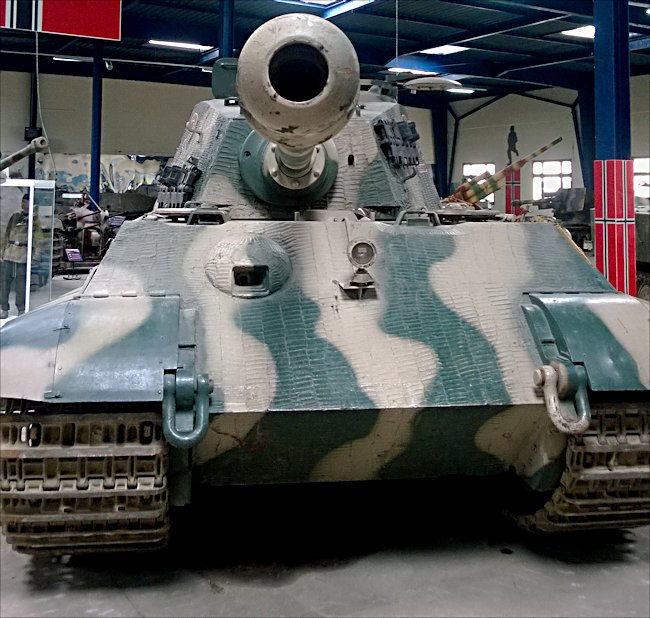
Notice how wide the tracks are on the King Tiger Tank. Compare them with a Panzer IV tank's tracks.
Why does the Tiger II look like a Panther?
The German tank designers had learnt the hard lessons of fielding tanks with under-powered guns that were incapable of penetrating the enemy tank’s front armour. This had happened in the 1940 invasion of France where German tank gun shells bounced off the front of French heavy tanks like the Char B1-bis and the British Matilda II tank.
During operation Barbarossa, the invasion of Russia, and the following Case Blue spring offensive, the German tanks were under-gunned. Especially when they came across the new Russian T34/76 and KV-1 tanks.
They introduced a new high velocity 75mm long barreled gun and put it in a number of their new armoured vehicles including the famous Panther tank. They worked on designs that would enable a tank to carry the very effective 88mm anti-tank gun. This resulted in the Tiger tank.
The Russians were introducing more innovate tank designs during the last years of the war to counter the Tiger tank threat. The Joseph Stalin IS-2 main battle tank and the ISU-152 assault gun are good example of this. The German tank designers were conscious that they could not rest on their laurels. They needed to produce a more lethal bigger tank to remain dominate on the battlefield.
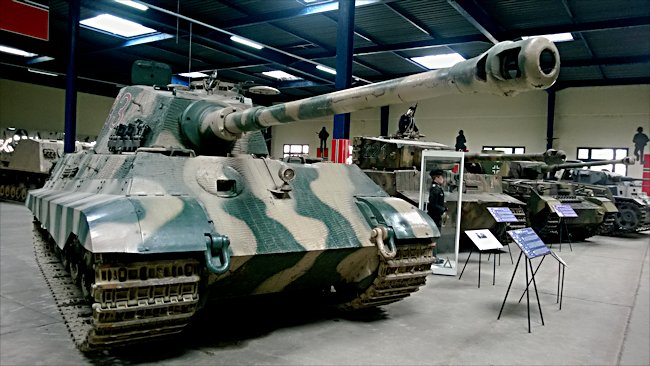
The Royal Tiger Tank's 88mm gun was lengthened.
Heavier protective armour required even larger tank hulls to carry the weight and mount the bigger guns. This resulted in the Tiger II ‘Royal Tiger’ or as the British called them, ‘King Tiger’ tank. It first enter active service on the Russian front May 1944. It resembled the Panther tank rather than the Tiger I tank.
It had thick sloping armour which made it practically indestructible if it was attacked from the front. The 88mm gun was improved by lengthening the barrel. The engine was underpowered and the weight of the king Tiger meant that bridges had to be tested before they could cross.
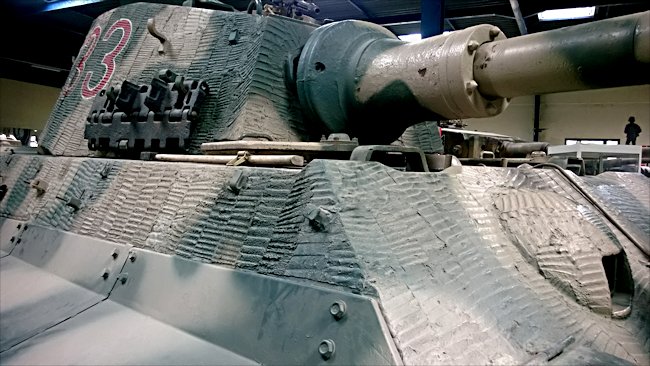
Notice that the King Tiger Tank's turret side armour is curved.
Germany started the war with 6 ton tanks and ended it with 70 tonne King Tigers and Jagdtigers, boasting an increase of ten times the firepower and protection. The main problem for the German army is that not enough of these difficult to produce expensive tanks could be made. The Russians could field swarms of cheap easy to produce T34/85 tanks. The Germans were just out numbered both on the Eastern and Western front by 1945.
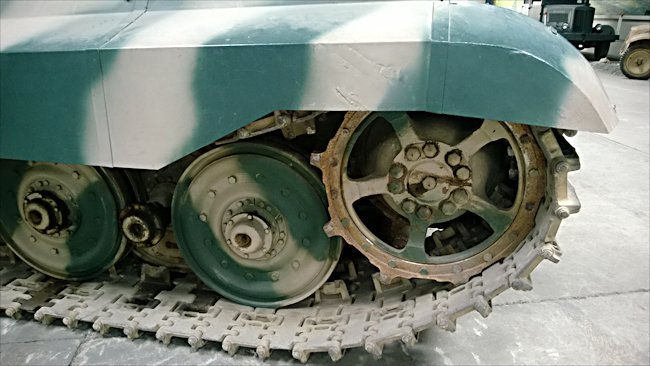
The over-laping wheels on the Tiger II Tank were problematic to change in the field.
How were most King Tiger tanks knocked out?
During the Battle of the Bulge on 13th January 1945 in the Belgium Ardennes, the German schwere Panzer-Abteilung 506 was advancing towards Bastogne as part of an eastern pincer movement. They had a number of King Tiger tanks as part of their battle group. One of these monster Tiger II tanks, was knocked out 10 km north-east of Bastogne in the village of Moinet by American armour belonging to the 15th Tank Battalion, 6th Armoured Division.
It was commanded by Leutant Jugen Tegethoff. It was hit by eight armour piercing rounds. The five rounds that hit the front of the King Tiger tank failed to penetrate the thick sloping armour. They just left gouge marks. The other three shells hit the left-hand side of the vehicle. One managed to penetrate a weak spots and caused the ammunition to explode which blowout the side of the tank and blasted the heavy turret into the air.
Another King Tiger tank was knocked out by direct armour piercing rounds near the Belgian town of Wardin. This one belonged to Schwere SS-Panzer-Abteilung 501. Two American armour piercing shells managed to penetrate the side of the vehicle, one in the middle of the right hand side of the main chassis and another just above it in the middle lower section of the side of the turret.
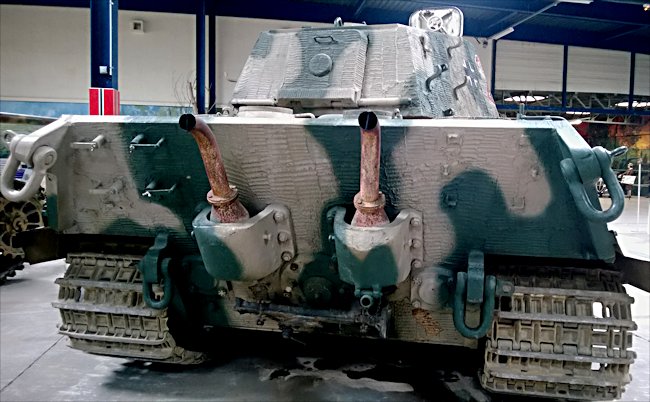
Even the thick rear armour on the back of the King Tiger Tank was sloped.
During the Battle of the Bulge it was rare that American anti-tank guns and main cannon is fitted to Sherman tanks and tank destroyers were able to knock out Tiger II tanks. They were normally knocked out by ground attack aircraft's rockets and bombs when they were seen in the open. Anti-tank mines also claimed a number of these monster heavy tanks. Because of the German engineer's lack of resources to deal with battlefield repairs most of these tanks had to be abandoned. Most King Tiger tanks were destroyed by their own crews. They simply ran out of fuel and ammunition. They use a grenade inside the vehicle surrender them unusable by the Americans.
Many King Tiger tanks were wrongly claimed as destroyed by various different American armoured units. This also included fighter-bombers of the United States air force and the RAF. Whenever you look at a black-and-white photograph of a knocked out Tiger II tank, have a look at the position of its main gun.
If it is pointing upwards then it usually means that the tank has been abandoned by its crew and sabotaged to prevent it falling into American hands and be used against them. The position of the gun barrel indicates that it is locked in the fully recoil position. The gun has been 'spiked' by its crew so it cannot be fired again.
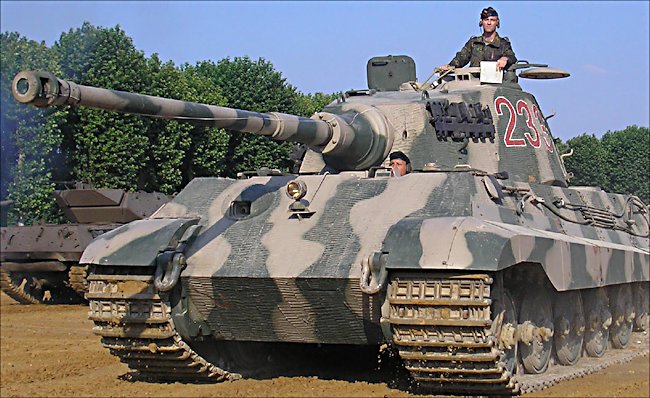
Once a year the Saumur King Tiger Tank goes out for a drive during Tank Fest.
King Tiger tanks survive air attack
During the Battle of the Bulge in December 1944, Werner Wendt was the tank commander of King Tiger tank number 133 which was part of the Schwere SS-Panzer-Abteilung. He had been assigned to the third platoon of the heavy tank detachment's 1st Kompanie. On the 18th December 1945 Tiger II tanks of the 2nd Kompanie were leading the way to capture the bridge at Stavelot in the Belgium Ardennes.
Wendt and the Tigers of his 1st Kompanie were following. As they were crossing the bridge 3:30 PM. They were strafed and bombed by USAF fighter-bombers. The intact. The entire length of the battle group's armoured column. Because of the thickness of the King Tiger's armour they all escaped unscathed, except for Tiger 131. It sustained minor damage to its tracks. Panzer Grenadier and paratroopers who arrived on top of the Tiger tanks, suffered casualties.
Where can I find other preserved King Tiger Tanks?
- (Porsche turret) – Bovington Tank Museum
- Bovington Tank Museum
- Munster Panzer Museum
- December 44 Museum, La Gleize, Belgium
- Musée des Blindés, Saumur, France
- Schweizerisches Militärmuseum, Full, Switzerland
- Kubinka Tank Museum, Russia
- National Armor and Cavalry Museum, Fort Benning, GA, USA
- Wreck - Fontenay-Saint-Père, France
- Wreck - The Wheatcroft Collection, England
- Source - Pierre-Oliver Buan - http://the.shadock.free.fr/Surviving_Panzers.html
WW2 tank books

